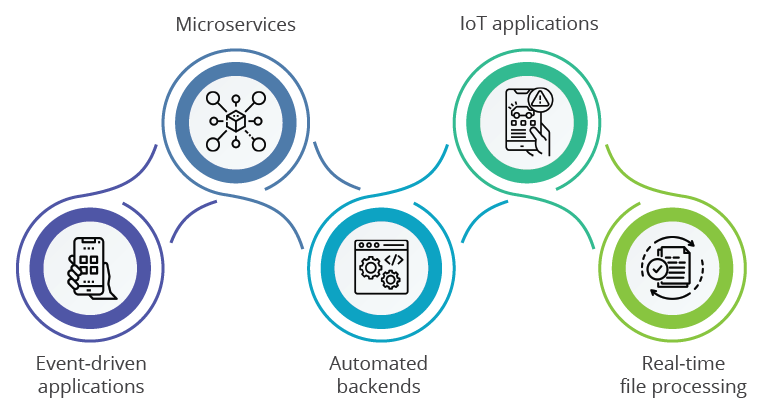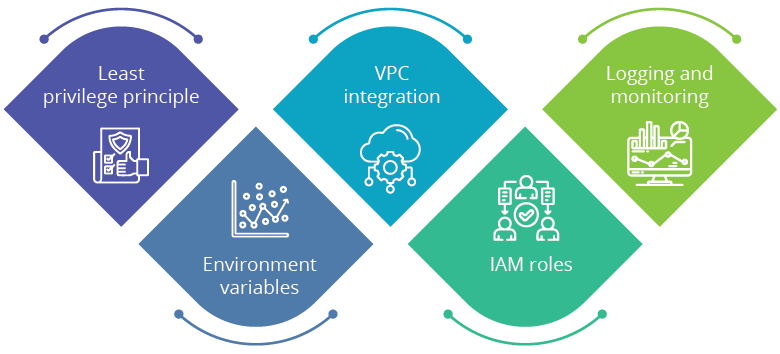
Jun 25, 2024
AWS Lambda, a core component of serverless architecture, empowers developers, cloud architects, data engineers, and business decision-makers by allowing code execution in response to specific events without managing servers. This flexibility is ideal for many modern applications but requires a nuanced understanding of its use cases, security considerations, performance factors, and cost implications to maximize its benefits.
In the first part, ‘exploring AWS lambda – a guide to serverless use cases,’ we saw how AWS Lambda enables efficient and scalable real-time data processing, facilitates backend services automation, supports microservices architecture, and enhances IoT applications by processing sensor data. It highlighted use cases like image processing, real-time notifications, and on-the-fly data transformations, emphasizing Lambda’s role in creating responsive, cost-effective applications without server management overhead.
Why it is important to understand AWS Lambda
Knowing when to use or avoid AWS Lambda is crucial for optimizing performance and cost. Our team of AWS experts emphasizes this while providing AWS consulting. For developers and cloud architects, this understanding leads to efficient resource allocation and streamlined workflows. Data engineers benefit from leveraging Lambda’s capabilities for real-time data processing, while business decision-makers can make informed choices about infrastructure investments, ensuring cost-effective and scalable solutions.
Statistics from AWS reveal a compelling fact: Companies leveraging Lambda for event-driven applications experience up to a staggering 70% reduction in operational costs. This potential for significant cost savings should motivate businesses to delve deeper into Lambda. Understanding its security implications can protect sensitive data, and optimizing performance ensures a seamless user experience. However, misuse or misunderstanding of Lambda can lead to increased costs, security vulnerabilities, and performance bottlenecks. This underscores the importance of gaining a comprehensive understanding of Lambda.
Where to use AWS Lambda
- Event-driven applications: AWS Lambda shines in event-driven scenarios. Imagine an e-commerce platform that processes and verifies customer orders. Lambda can trigger functions upon order placement, ensuring swift and reliable processing. This event-driven model streamlines operations and reduces latency. For developers, this means faster deployment and reduced overhead.
- Microservices: Lambda’s modular nature makes it a perfect fit for microservices architecture. Each function can be developed, deployed, and scaled independently. For example, a social media platform can use Lambda to handle user notifications, where each type of notification is a separate microservice, allowing for isolated management and scaling. Cloud architects will find this helpful in designing scalable and maintainable systems.
- Automated backends: For tasks like user authentication, data validation, or generating reports, Lambda offers an automated, scalable backend solution. This is particularly effective for applications with sporadic workloads, as Lambda only runs when needed, saving costs on idle server time. Business decision-makers benefit from cost efficiency and flexibility.
- IoT applications: In IoT ecosystems, Lambda can process data from connected devices in real-time. For instance, a smart home system might use Lambda to analyze sensor data and trigger actions such as adjusting the thermostat or sending alerts, ensuring responsive and efficient device management. Data engineers can leverage Lambda for seamless data processing and integration.
- Real-time file processing: Lambda is excellent for real-time file processing. Consider a photo-sharing application where users upload images. Lambda functions can automatically resize images and store them in various formats in an S3 bucket, ensuring a seamless user experience.
Suggested: Apart from when to use Lambda, do you want to know more about why successful businesses are cloud-based? Read this!
Where not to use AWS Lambda
- Long-running processes: Lambda functions have a maximum execution time of 15 minutes. For applications requiring longer processing times, like video rendering or extensive data analysis, traditional EC2 instances or ECS services are more suitable.
- High-performance computing: Tasks requiring significant computational power, such as complex simulations or machine learning model training, may need to improve on Lambda due to its limited resource allocation compared to dedicated HPC solutions. Developers working on resource-intensive applications should consider more powerful options.
- Steady load applications: For applications with a predictable, continuous load, such as streaming services, maintaining dedicated servers or using containerized environments can be more cost-effective. Lambda’s pay-per-request model may lead to higher costs for sustained high-volume traffic.
- Complex state management: Applications requiring persistent connections or complex state management, such as multiplayer online games or real-time chat applications, may face challenges with Lambda. Maintaining a state across stateless function invocations can take time and effort. Cloud architects should consider traditional server setups for such use cases.
Security implications of AWS Lambda
- Least privilege principle: Lambda functions should follow the principle of least privilege, ensuring they have only the necessary permissions to perform their tasks. This minimizes the risk of unauthorized access and potential security breaches. Cloud architects must ensure strict access controls and permission settings.
- Environment variables: Avoid storing sensitive data like API keys or credentials in environment variables. Instead, utilize AWS Secrets Manager or AWS Systems Manager Parameter Store for secure storage and retrieval of sensitive information. Developers should follow best practices for handling confidential information.
- VPC integration: Running Lambda functions within a Virtual Private Cloud (VPC) can enhance security by restricting network access to AWS resources. This isolates Lambda functions from the public internet, reducing exposure to potential attacks. Security-conscious architects can leverage VPC integration for additional protection.
- IAM roles: Properly configured IAM roles and policies are crucial for Lambda functions. Assigning specific roles to functions ensures they can access only the resources they need, reducing the risk of privilege escalation.
- Logging and monitoring: Enabling logging with AWS CloudWatch allows for real-time monitoring of Lambda function activity. Setting up alerts for unusual behavior helps promptly detect and respond to security incidents.
Suggested: Check out the ultimate guide to application integration on AWS!
Performance and cost impact of using AWS Lambda
Performance
- Cold starts: Cold starts occur when a Lambda function is invoked after inactivity, leading to initialization latency. While this can impact performance, using Provisioned Concurrency can keep functions warm, reducing latency for critical functions. Developers should be aware of this to ensure responsive applications.
- Resource allocation: Optimizing memory and timeout settings can significantly enhance performance. Allocating adequate memory ensures functions execute efficiently, reducing execution time and improving user experience.
- Concurrency limits: Managing concurrency limits is essential to avoid throttling issues. By monitoring CloudWatch metrics, you can adjust concurrency settings to ensure smooth operation during peak times. Cloud architects need to manage these settings to maintain application reliability.
Cost
- Pay-per-use model: Lambda’s pricing is based on the number of requests and the duration of code execution. This model is cost-effective for applications with sporadic usage patterns, as you only pay for actual compute time. Business decision-makers will appreciate the cost savings and scalability.
- Free tier: AWS offers a generous free tier for Lambda, including 1 million free requests and 400,000 GB-seconds of compute time per month. This makes it an attractive option for startups and small-scale applications.
- Cost management: Regularly reviewing usage and optimizing function performance can help avoid unnecessary costs. Implementing cost monitoring and alerts through AWS Cost Explorer or similar tools ensures you stay within budget.
Also read: How can you maximize savings by avoiding five common mistakes that increase your AWS bill?
Identifying performance issues in AWS Lambda
- Cold start latency: Analyze logs to identify high latencies due to cold starts. Provisioned concurrency can mitigate these delays by pre-warming functions. Developers should monitor these metrics to enhance user experience.
- Timeout errors: Monitoring for timeout errors indicates whether functions need more execution time or optimization. Adjusting timeout settings or refining code can resolve these issues. Cloud architects should ensure functions are correctly tuned to avoid disruptions.
- Throttling: Throttling events, visible in CloudWatch metrics, indicate that the concurrency limit has been reached. Adjusting concurrency settings or optimizing function performance can help prevent throttling. Business decision-makers should consider these metrics when planning for scalability.
- Memory usage: Evaluating memory usage metrics ensures functions are adequately provisioned. Under-provisioned functions can suffer from performance issues, while over-provisioning can lead to unnecessary costs. Data engineers should optimize memory settings for efficient data processing.
- Execution duration: Optimizing code to reduce execution time improves performance and controls costs. Efficient code execution minimizes the time functions run, leading to cost savings.
Summary
By understanding where to use and where not to use Lambda, security practices, performance considerations, and cost implications of Lambda, organizations can effectively leverage serverless computing to build scalable, efficient, and secure applications. Here’s a summarized view:
|
Aspect |
Recommendations |
|---|---|
|
Where to use Lambda |
Event-driven apps, microservices, automated backends, IoT and real-time file processing. |
|
Where not to use Lambda |
Long-running processes, high-performance computing, steady load apps and complex state management. |
|
Security implications |
Least privilege, secure environment variables, VPC integration, IAM roles and logging |
|
Performance considerations |
Mitigate cold starts, optimize resource allocation and manage concurrency limits. |
|
Cost impacts |
Utilize pay-per-use, leverage free tier, regular cost review and optimization |
This comprehensive understanding ensures that you can maximize the benefits of AWS Lambda while mitigating potential drawbacks, leading to robust and cost-effective applications.
Need Help ?
We are here for you





